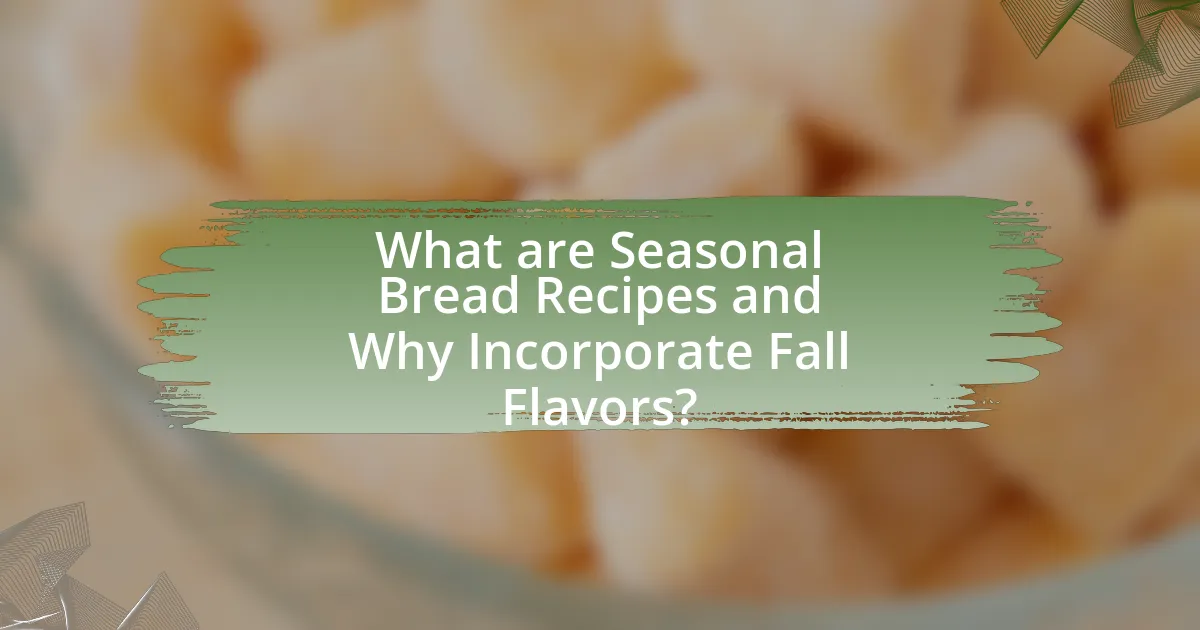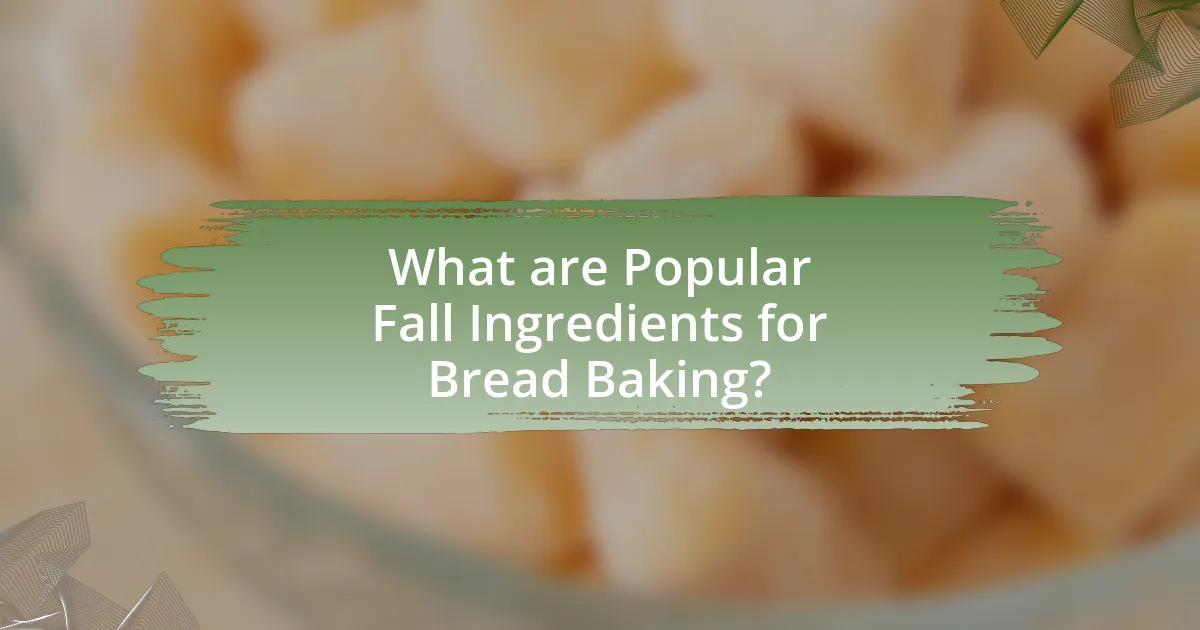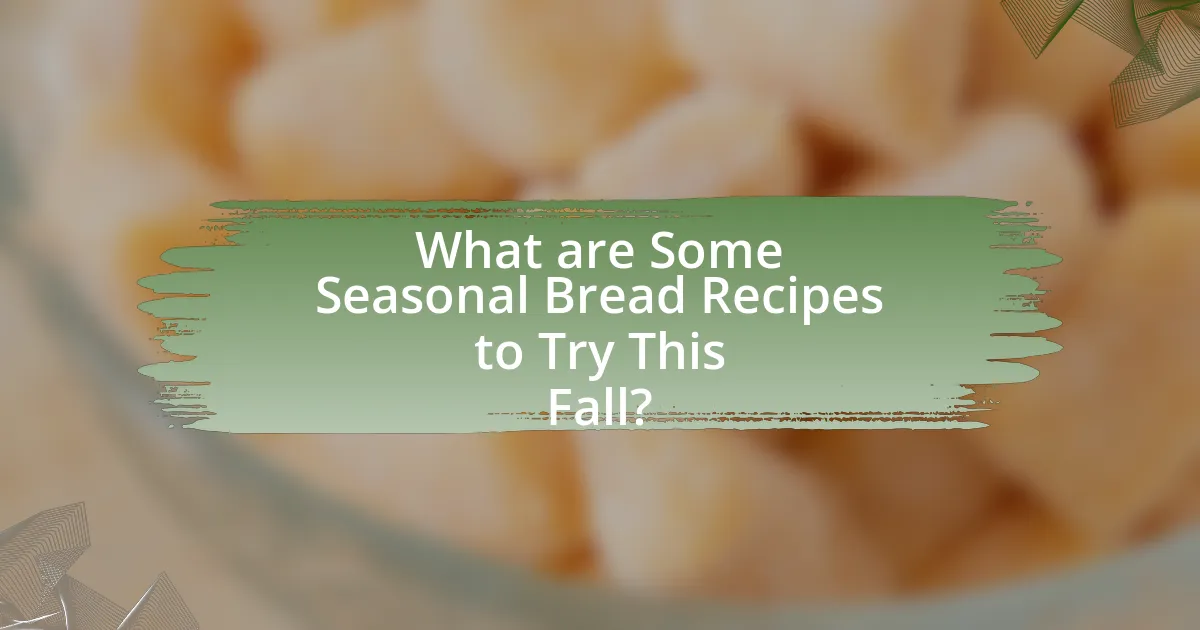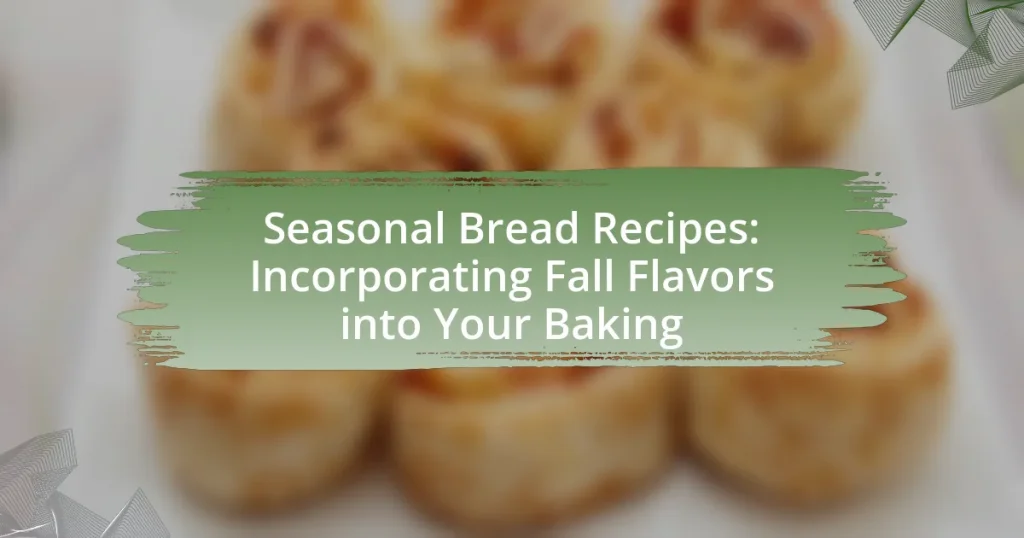Seasonal bread recipes focus on incorporating ingredients and flavors that are characteristic of specific seasons, particularly fall. This article explores the benefits of using seasonal ingredients such as pumpkin, apples, and spices like cinnamon and nutmeg, which enhance the taste, texture, and nutritional value of baked goods. It also discusses popular fall flavors, innovative recipe ideas, and the importance of sustainability in baking with seasonal produce. Additionally, the article provides practical tips for achieving the perfect rise in bread and avoiding common baking mistakes, making it a comprehensive guide for bakers looking to embrace the flavors of autumn.

What are Seasonal Bread Recipes and Why Incorporate Fall Flavors?
Seasonal bread recipes are baked goods that utilize ingredients and flavors associated with specific seasons, particularly fall, which often includes spices like cinnamon, nutmeg, and ingredients such as pumpkin and apples. Incorporating fall flavors into these recipes enhances the sensory experience of baking and aligns with seasonal harvests, making the bread more relevant and enjoyable during this time of year. For example, pumpkin bread not only reflects the abundance of pumpkins in fall but also evokes the warmth and comfort associated with the season, making it a popular choice among bakers and consumers alike.
How do seasonal ingredients enhance bread recipes?
Seasonal ingredients enhance bread recipes by introducing fresh, vibrant flavors and textures that reflect the time of year. For example, using ingredients like pumpkin, apples, or spices such as cinnamon and nutmeg in fall recipes not only adds unique taste profiles but also increases the nutritional value of the bread. Seasonal ingredients are often harvested at their peak ripeness, ensuring optimal flavor and freshness, which can significantly elevate the overall quality of the bread. Additionally, incorporating these ingredients can create a connection to seasonal traditions and celebrations, making the baking experience more meaningful.
What are the key fall flavors to consider in baking?
The key fall flavors to consider in baking include pumpkin, apple, cinnamon, nutmeg, and pecan. Pumpkin is often used in pies and breads, providing a rich, earthy sweetness. Apples, particularly varieties like Granny Smith and Honeycrisp, add tartness and moisture to baked goods. Cinnamon and nutmeg are essential spices that evoke warmth and comfort, commonly found in recipes for cakes and cookies. Pecan offers a crunchy texture and a buttery flavor, enhancing desserts like pies and tarts. These flavors are widely recognized for their seasonal appeal, making them staples in fall baking.
How do seasonal ingredients affect the taste and texture of bread?
Seasonal ingredients significantly enhance the taste and texture of bread by introducing unique flavors and moisture levels. For instance, using autumn ingredients like pumpkin or apples can impart a natural sweetness and moisture, resulting in a softer crumb and richer flavor profile. Additionally, spices such as cinnamon or nutmeg, commonly associated with fall, add warmth and complexity to the bread’s taste. Research indicates that the incorporation of these seasonal elements not only diversifies the flavor but also affects the bread’s overall structure, as the moisture content from ingredients like pureed pumpkin can lead to a denser, more tender loaf.
What are the benefits of baking with seasonal flavors?
Baking with seasonal flavors enhances the taste and freshness of baked goods. Seasonal ingredients, such as pumpkins, apples, and spices like cinnamon, are at their peak flavor and nutritional value during their respective seasons, leading to more vibrant and satisfying dishes. Additionally, using seasonal flavors supports local agriculture and reduces carbon footprints associated with transporting out-of-season produce. Research indicates that seasonal eating can also contribute to a more varied diet, which is beneficial for overall health.
How does using seasonal ingredients promote sustainability?
Using seasonal ingredients promotes sustainability by reducing the carbon footprint associated with transportation and storage. When ingredients are harvested at their peak season, they require less energy for refrigeration and long-distance shipping, which significantly lowers greenhouse gas emissions. For instance, a study by the Food and Agriculture Organization indicates that local sourcing of seasonal produce can cut food miles by up to 90%, thereby minimizing environmental impact. Additionally, seasonal farming practices often align with natural growing cycles, promoting biodiversity and healthier ecosystems. This approach not only supports local economies but also encourages sustainable agricultural practices that are less reliant on chemical inputs.
What health benefits can be gained from seasonal baking?
Seasonal baking offers several health benefits, primarily through the use of fresh, seasonal ingredients that are often more nutrient-dense. For example, baking with fall ingredients like pumpkins, apples, and spices such as cinnamon can enhance nutritional value; pumpkin is rich in vitamins A and C, while apples provide dietary fiber and antioxidants. Additionally, using whole grains in seasonal recipes can improve heart health by lowering cholesterol levels and providing essential nutrients. Research indicates that incorporating seasonal produce into diets can lead to increased consumption of vitamins and minerals, supporting overall health and well-being.

What are Popular Fall Ingredients for Bread Baking?
Popular fall ingredients for bread baking include pumpkin, apples, cinnamon, nutmeg, and pecans. These ingredients are commonly used due to their seasonal availability and flavor profiles that evoke the essence of autumn. For instance, pumpkin puree adds moisture and a rich flavor, while apples provide natural sweetness and texture. Spices like cinnamon and nutmeg enhance the warmth and aroma of baked goods, making them particularly appealing during the fall season. Additionally, pecans contribute a crunchy texture and nutty flavor, complementing the other ingredients effectively.
Which fruits and vegetables are commonly used in fall bread recipes?
Common fruits and vegetables used in fall bread recipes include pumpkin, apples, pears, and sweet potatoes. These ingredients are favored for their seasonal availability and ability to enhance flavor and moisture in baked goods. For example, pumpkin is often used in recipes for its rich texture and natural sweetness, while apples and pears add a fruity note and moisture. Sweet potatoes contribute a subtle sweetness and vibrant color, making them popular choices in autumn baking.
How can apples and pumpkins be incorporated into bread?
Apples and pumpkins can be incorporated into bread by using their purees or grated forms as key ingredients in the dough. For instance, pumpkin puree adds moisture and a rich flavor, while grated apples contribute natural sweetness and texture. Recipes often call for combining these ingredients with flour, sugar, spices like cinnamon and nutmeg, and leavening agents to create a balanced batter. The use of pumpkin in bread is supported by its high fiber content and vitamins, making it a nutritious addition, while apples provide antioxidants and enhance the overall flavor profile.
What spices are essential for fall-flavored breads?
Essential spices for fall-flavored breads include cinnamon, nutmeg, ginger, and allspice. These spices are commonly used in autumn baking due to their warm, aromatic profiles that evoke the essence of the season. For instance, cinnamon is known for its sweet and spicy flavor, while nutmeg adds a rich, nutty warmth. Ginger contributes a zesty kick, and allspice offers a blend of flavors reminiscent of cloves and cinnamon. Together, these spices create the characteristic taste associated with fall breads, making them popular choices in seasonal recipes.
What are some unique flavor combinations for fall breads?
Unique flavor combinations for fall breads include pumpkin and sage, apple and cinnamon, and maple and pecan. Pumpkin and sage create a savory bread that highlights the earthiness of pumpkin with aromatic sage, making it perfect for autumn meals. Apple and cinnamon combine sweet and spicy notes, resulting in a comforting bread ideal for breakfast or snacks. Maple and pecan offer a rich, nutty flavor profile, with maple syrup adding sweetness and pecans providing crunch, making it a delightful treat for fall gatherings. These combinations reflect seasonal ingredients and enhance the warmth associated with fall baking.
How can nuts and seeds enhance the flavor profile of fall breads?
Nuts and seeds enhance the flavor profile of fall breads by adding rich, earthy tastes and crunchy textures. For instance, walnuts contribute a slightly bitter, nutty flavor that complements spices like cinnamon and nutmeg commonly used in fall recipes. Similarly, pumpkin seeds provide a subtle sweetness and a satisfying crunch, which can elevate the overall sensory experience of the bread. The incorporation of these ingredients not only enriches the taste but also adds nutritional benefits, such as healthy fats and protein, making the bread more wholesome.
What role do sweeteners play in fall bread recipes?
Sweeteners enhance the flavor, texture, and moisture of fall bread recipes. They contribute to the overall taste profile by balancing the spices commonly used in autumn, such as cinnamon and nutmeg, while also providing a pleasant sweetness that complements ingredients like pumpkin and apples. Additionally, sweeteners help to retain moisture in the bread, resulting in a softer crumb and extended shelf life. For instance, recipes often utilize brown sugar or maple syrup, which not only sweeten but also add depth and richness, aligning with the seasonal theme of comfort and warmth in fall baking.

What are Some Seasonal Bread Recipes to Try This Fall?
Some seasonal bread recipes to try this fall include pumpkin bread, apple cinnamon bread, and maple pecan bread. Pumpkin bread combines pureed pumpkin with spices like cinnamon and nutmeg, creating a moist loaf that reflects the flavors of the season. Apple cinnamon bread incorporates fresh apples and warm spices, offering a sweet and comforting option. Maple pecan bread features maple syrup and toasted pecans, providing a rich, nutty flavor that is perfect for fall baking. These recipes utilize ingredients that are abundant in the fall, making them ideal for seasonal baking.
How do you make classic fall bread recipes?
To make classic fall bread recipes, combine ingredients that reflect seasonal flavors, such as pumpkin, cinnamon, and nutmeg. For example, a pumpkin bread recipe typically includes pureed pumpkin, flour, sugar, eggs, baking soda, and spices. Mix the dry ingredients separately from the wet ingredients, then combine them until just mixed to avoid overworking the dough. Pour the batter into a greased loaf pan and bake at 350°F for about 60 minutes, or until a toothpick inserted in the center comes out clean. This method is validated by numerous traditional recipes that highlight the use of seasonal ingredients to create rich, flavorful breads enjoyed during the fall months.
What is the recipe for pumpkin spice bread?
The recipe for pumpkin spice bread includes the following ingredients: 1 cup of canned pumpkin puree, 1 cup of granulated sugar, 1/2 cup of vegetable oil, 2 large eggs, 1 1/2 cups of all-purpose flour, 1 teaspoon of baking soda, 1/2 teaspoon of baking powder, 1 teaspoon of ground cinnamon, 1/2 teaspoon of ground nutmeg, 1/2 teaspoon of ground ginger, and 1/4 teaspoon of salt.
To prepare the bread, preheat the oven to 350°F (175°C). In a mixing bowl, combine the pumpkin puree, sugar, and oil, then beat in the eggs. In a separate bowl, whisk together the flour, baking soda, baking powder, spices, and salt. Gradually add the dry ingredients to the wet mixture, stirring until just combined. Pour the batter into a greased loaf pan and bake for 60-70 minutes, or until a toothpick inserted in the center comes out clean.
This recipe is validated by its popularity in seasonal baking, particularly during the fall, where pumpkin spice flavors are widely embraced.
How can you create an apple cinnamon loaf?
To create an apple cinnamon loaf, combine flour, sugar, baking powder, cinnamon, and salt in a bowl. In a separate bowl, mix eggs, milk, melted butter, and diced apples. Gradually add the wet ingredients to the dry ingredients, stirring until just combined. Pour the batter into a greased loaf pan and bake at 350°F (175°C) for about 50-60 minutes, or until a toothpick inserted in the center comes out clean. This method is effective as it utilizes common baking techniques and ingredients that enhance the seasonal flavor profile of apple and cinnamon.
What are some innovative twists on traditional fall breads?
Innovative twists on traditional fall breads include pumpkin spice sourdough, apple cinnamon challah, and maple pecan brioche. Pumpkin spice sourdough combines the classic tang of sourdough with the warm flavors of pumpkin and spices, appealing to seasonal tastes. Apple cinnamon challah incorporates fresh apples and cinnamon into the braided bread, enhancing its sweetness and texture. Maple pecan brioche uses maple syrup and toasted pecans to create a rich, nutty flavor profile, making it a delightful addition to fall baking. These variations not only celebrate fall ingredients but also offer unique textures and flavors that elevate traditional recipes.
How can you incorporate savory elements into sweet fall breads?
Incorporating savory elements into sweet fall breads can be achieved by adding ingredients such as herbs, cheeses, or spices. For example, incorporating rosemary or thyme can enhance the flavor profile, while adding a sharp cheese like cheddar can create a delightful contrast to the sweetness of the bread. Additionally, spices such as black pepper or smoked paprika can introduce a savory depth that complements traditional fall flavors like pumpkin or apple. These combinations not only elevate the taste but also create a more complex and enjoyable eating experience.
What are some gluten-free options for fall bread recipes?
Gluten-free options for fall bread recipes include almond flour bread, pumpkin bread made with gluten-free flour, and apple cinnamon bread using oat flour. Almond flour bread provides a nutty flavor and moist texture, while pumpkin bread can be made with a blend of gluten-free all-purpose flour and pumpkin puree, which adds seasonal flavor and moisture. Apple cinnamon bread can be created using oat flour, which offers a hearty base and pairs well with the sweetness of apples and spices. These alternatives cater to gluten-free diets while embracing the flavors of the fall season.
What tips can help improve your fall bread baking experience?
To improve your fall bread baking experience, focus on using seasonal ingredients like pumpkin, apples, and spices such as cinnamon and nutmeg. Incorporating these flavors enhances the bread’s aroma and taste, making it more aligned with fall themes. For instance, pumpkin puree adds moisture and a rich flavor, while spices contribute warmth and depth. Additionally, adjusting your baking techniques, such as allowing for longer fermentation times, can improve the texture and flavor complexity of the bread. Research indicates that longer fermentation enhances the development of flavor compounds, resulting in a more satisfying final product.
How can you ensure the perfect rise in your seasonal breads?
To ensure the perfect rise in your seasonal breads, use the right yeast and maintain optimal fermentation conditions. Active dry yeast or instant yeast should be used, as they provide reliable leavening. Additionally, the dough should be kept in a warm, draft-free environment, ideally around 75-80°F (24-27°C), to promote yeast activity. Proper hydration is also crucial; a dough with 60-70% hydration allows for better gluten development, which supports the rise. Finally, allowing sufficient time for both the first and second rises, typically 1-2 hours each, ensures that the dough has enough time to expand fully.
What common mistakes should you avoid when baking with fall flavors?
When baking with fall flavors, avoid using overly strong spices that can overpower the dish. Many bakers mistakenly add excessive amounts of cinnamon, nutmeg, or cloves, which can lead to an unbalanced flavor profile. Instead, use these spices in moderation to enhance the natural sweetness of ingredients like pumpkin or apple. Additionally, failing to account for moisture content in fall ingredients, such as pureed pumpkin, can result in overly dense or soggy baked goods. Properly measuring and adjusting the liquid ingredients is crucial for achieving the desired texture. Lastly, neglecting to taste and adjust the sweetness can lead to bland results; fall flavors often benefit from a touch of sweetness to complement their richness.




